 Editor’s note: many of us at GunsAmerica are just as passionate about our knives as we are about guns. And we’re on a quest. We’re looking deep into the design of some contemporary knives in search of the perfect fighting knife. This is the first of those explorations. We couldn’t look at contemporary designs without considering a couple of historical examples. So we’ve got Sam checking out the Ka-Bar.
Editor’s note: many of us at GunsAmerica are just as passionate about our knives as we are about guns. And we’re on a quest. We’re looking deep into the design of some contemporary knives in search of the perfect fighting knife. This is the first of those explorations. We couldn’t look at contemporary designs without considering a couple of historical examples. So we’ve got Sam checking out the Ka-Bar.
And no–just to be clear on this–we’re not affiliated with Ka-Bar. Though we respect the brand, they’ve sent no products for this review. They don’t advertise with us. So if this write up seems like a love fest, you can rest assured that it is just our nostalgia and respect creeping in.
The Ka-Bar Combat Knife is arguably the most iconic American blade. The only one I can think of that’s more infamous is the old-school Bowie. Like ordering a “Coke” in the south (then asking for a Dr. Pepper), Ka-Bar is one of those company names that has become a catch-all for a bunch of knives.
Kill-a-bear
In 1923, the Union Cutlery Company trademarked the Ka-Bar name. There is a bit of legend (or clever marketing) behind the origin of the name. The most popular story is that the company received a letter from a fur trapper that claimed to have killed a bear with one of their knives. The letter was said to be hard to read from damage and the only letters readable in the “kill a bear” phrase were “k a bar”.
Soon after receiving the letter, Union Cutlery started stamping some of their knives with the Ka-Bar name. These were on switchblade knives called the Grizzly and Baby Grizzly, which are a far cry from the famed WWII era knife.
WWI Knives sucked
We will return to the Union Cutlery Co. here in a bit, but first we need to talk about the development of what became known as the Ka-Bar knife.
As the US entered WWII, there was a need for a multipurpose knife. A knife could be used for cutting rope, prying open ammo crates, and stabbing someone if the need arose. The standard US knife in use at the start of the war was from the First World War. It was heavy, expensive, and the blades where prone to breaking when using them to pry. It also had built in brass knuckles that looked bad ass but were not very practical. The over sized grips made the knives hard to carry securely and also limited the way in which the user could grip it.
[two_third]
[/two_third][one_third_last]
[/one_third_last]
The Marines issued a Stiletto style knife to some of the Raider units in the Pacific in the early part of WWII. This was basically a knockoff of the Fairbairn-Sykes Fighting knife of British fame. The Marine issued Stiletto turned out to be a great fighting or “silent killing” knife. The Fairbairn-Sykes design is one of the best fighting knives there is. But it is not a utility knife. Normal chopping, cutting and prying could (and did) break blades. The Marines eventually came to the conclusion that they needed a blade that could fight and also serve as a utility knife. This was further reinforced by the number of civilian hunting knives that Marines were buying and using in the Pacific in place of the issued knives.
[full_width]

The British Fairbairn- Sykes fighting knife was a favorite of some who liked dedicated fighting knives.
[/full_width]
Best of both worlds
The Marine Quartermaster and Ordnance Departments requested several knife and tool makers to submit designs for the new knife. Ultimately a design from Union Cutlery (with a lot of input from the USMC) was adopted. This knife had a longer, thicker and stronger blade than the others before it. It also had a clipped point, a fuller, a steel guard, and a stacked leather handle for grip. The final touch was to parkerize the knife. It was officially adopted in November of 1942 and given the designation of 1219C2. In many ways, the knife was a throw-back to what had become the familiar image of the Bowie.
[full_width]
[/full_width]
The first production run was made by Camillus Cutlery and shipped in January of 1943. The Navy liked the new Marine knife so much, and its faster and cheaper manufacture over the current Naval Knife, that they adopted it as the US Navy Utility Knife, Mark 2. The Marines changed the designation as well to USMC Mark 2 Combat Knife. And there you have it, a Utility and a Combat all in one knife.
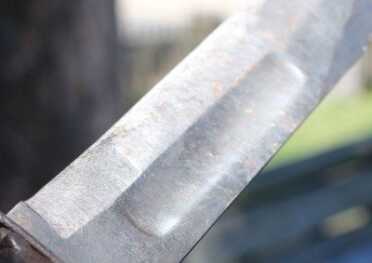
Some think the fuller is a weight reduction, but it doesn’t remove much metal. The fullers do appear to be ground out, though–which is odd for a war-time piece as it wastes steel and requires more work.
Why the 7″ blade?
At the Blade show this past June, some of the GunsAmerica crew got a good dressing down from the crew from Ka-Bar. We’d been asking questions about knives and knife design. Part of our quest includes looking at the modern options that would be solid additions to a vest. The Ka-Bar, with its size, seems like over-kill. Pro-tip: don’t say that to Ka-Bar. They’re proud of the 7″ blade on this knife. Why?
Like every other feature on the knife, it is purposeful. The designers look at the human body from every angle. The knife, when held with the blade out to the front, easily punctures a torso and and can be forced into the chest cavity to its full length (assuming it does strike a rib or a backbone). The same can be said for the side. If you swing the blade into someone under their arm, it will still penetrate deeply.
This depth is important. One plunge can rupture lungs (maybe both of them if you come in high and from the side). And that same depth allows access to major arteries and the heart. There is only one thing that has ever killed a human being: a lack of oxygenated blood to the brain. Exsanguination is key. People don’t die quickly when you stab them, and they will often continue to fight until the lack of blood incapacitates them. The philosophy here is that the more they bleed, the sooner they die. Plain and simple.
Morbid? Hell yeah. But that’s the point. There’s no way to sugar coat this. The blade is designed to reach the heart from whatever angle or side of the body you happen to be swinging from. This knife was purpose built, and it served its purpose well.
Is the length of the blade as important at the folks at Ka-Bar believe? We’ll dive into that in a future piece.
So it’s called a Ka-Bar?
No where in the official Navy or Marine history of this knife was it called a Ka-Bar. Union Cutlery did make the prototype that was later adopted, but Camillus was the first to ship actual production knives to the Marines in the field. Camillus was also the largest producer of the knives (making over 1 million of them which were marked “Camillus. N.Y.”). Robeson, Pal and Union Cutlery all made the Mark 2 knives under contract during WWII. Union Cutlery was the only one to mark the knives with the Ka-Bar name. By 1944 the Mark 2 started to be called the Ka-Bar by Marines in the field, no matter who made the knife or what name was on it. The name stuck. To this day when someone mentions Ka-Bar, the Mark 2 is the knife most people think of.
So who makes them today?
Check out Ka-Bar and see the current production models in all their glory: https://www.kabar.com/
Just about everyone has made a version. These are the 1911s of the knife world–decidedly American, made by everyone, easily recognizable, and endlessly capable. They’ve been made of every kind of knife-steel.
Ka-Bar still makes them. They make most of the from 1095 Cro-Van, which is a standard in the industry. They even make some out of D2, which is high carbon steel with corrosion resistance similar to stainless steels.They make tanto shapes, serrated blades, new materials, new handle materials and shapes, big one, little one, commemorative ones, decorative blades…. Again, going back to the 1911 comparison, you can buy one that looks like an original, or you can take your pick of the endless variety.
There are cheap imports, expensive imports, and versions made by a lot of American icons like Case, Cold Steel, Ontario. Not all of them stay in production, but they’re out there on the used market. Always.
[full_width]
[/full_width]
[full_width]
[/full_width]
[full_width]
[/full_width]
[full_width]
[/full_width]
[full_width]
[/full_width]
Crisitcsms?
Of course. There are many. We worked with what we had, no? The high carbon composition of the original blades worked well for cutting and edge retention. But they can be brittle if not tempered correctly. They may baton well, or they may not. Hammering on the back may loosen the guard.

See where light is seeping in between the blade and guard? That’s where the blade often breaks–where the somewhat square shouldered cut enters the grip.
And then there’s the leather handle. If cared for properly, it will last forever. If not, it shrinks, cracks, rots, etc. The same goes for the sheaths. Originals with sheaths in good condition are a rare find.
And then there’s the material construction. Ask any knife junky about strength of the blade, and they’ll eventually get to the tang design. A full tang is a must. If a Ka-Bar is going to break, it will be where the blade enters the grip. There were a lot of broken blades over the years, and some of the repairs made for some stunning works of art (see photo below).
Hardly the end
The Ka-Bar is iconic, no doubt, but it has hardly reached the end of its history. This is a fantastic knife. Even with the design limitations and material constraints of a nation at war, the Ka-Bar still kicked ass. The modern versions remain popular, and the influence can be seen in thousands of knives and bayonets in service today.
[full_width]

Jack “Bull Moose” Conklin, Jr.’s WWII knife. Handle and guard made from salvaged Japanese aircraft parts. Pacific Theater. H/T Pinterest.
[/full_width]
[one_half]
[/one_half][one_half_last]

This old blade has been in service a long time. Until my cousin (not the original owner) died in 1996, it was in use as a utility knife.
[/one_half_last]
[one_half]

Someone attacked this blade with a file in an effort to sharpen it, and they didn’t file off a new secondary edge. Instead, they ran it up the original grind lines.
[/one_half][one_half_last]
[/one_half_last]
[full_width]
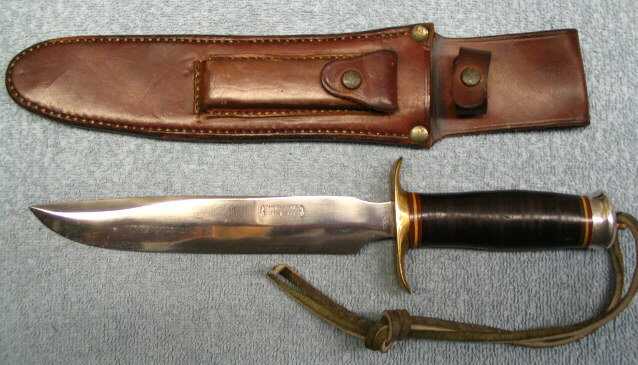
For those who want an advanced course on WWII fighting knives, I’d suggest looking at Randall. These custom made knives were reportedly capable of one-swipe decapitation–which rapidly speeds up the exsanguination process.
[/full_width]


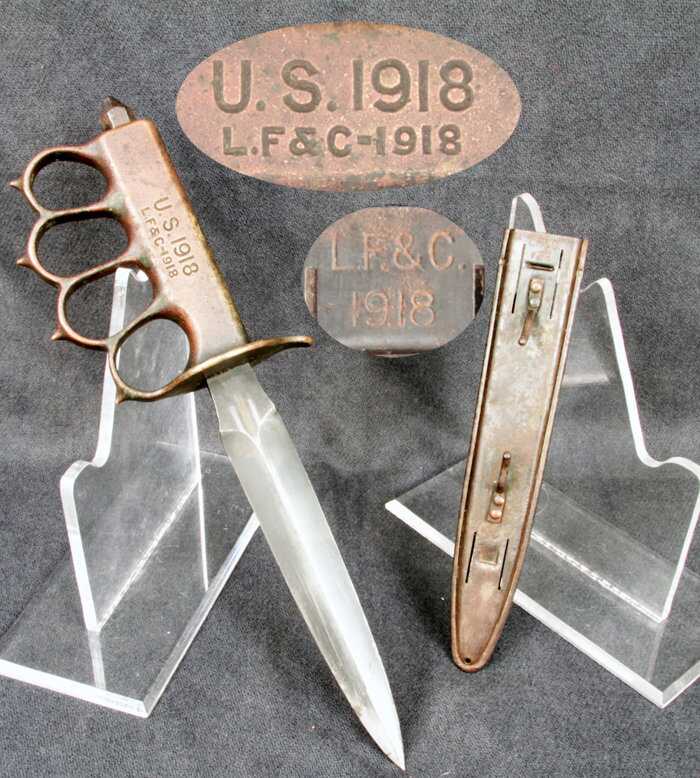

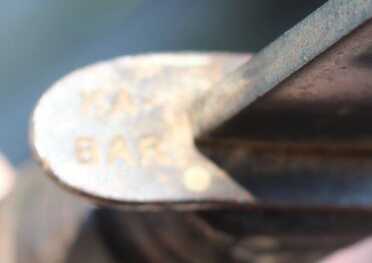
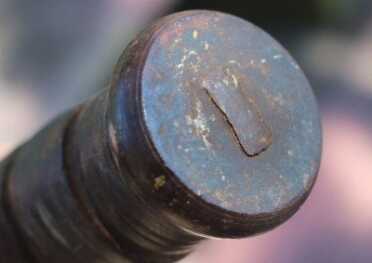





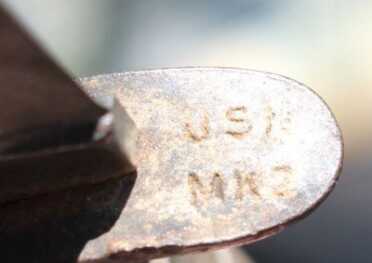

Nice blog.
Great to see your list of Ka bar combat knife.
Thank you for sharing.Rammy
DMA Inc.
I have a ranger knife allegedly issued to Darbys Rangers, again allegedly acquired by my uncle during WW11. Leather handle and sheath. I can find no info . I do know this knife was in my father’s possession in the 1950’s or before. Any insights would be appreciated. Mark.
It’s probably a Fairbanks Sykes Fighting knife, if I had to guess.
The “hand guards are swept back to further control slippage. The developers of this knife knew that o ve a knife becomes saturated with blood and sweat, it has long been known that the hand gets pretty slippery. In a combat situation the back swept hand guard no only limits penetration bit helps keep control of the weapon in combat.
I should also add that many bear were killed by spear and knife before there were guns. That’s when people knoew how to fight back. There are recorded instances in historical references.
Today we simply have guns and high powered bows to make it easy. But I always carry a 7 or 9 in blade when in the wild besides my shooter. Don’t you remember those great Tarzan Movies??? LOL.
Johnny Weissmuller-yes sir! Tarzan killed Rhinos, alligators, and lions with a knife.
I should also add that many bear were killed by spear and knife before there were guns. That’s when people knoew how to fight back. There are recorded instances in historical references.
Today we simply have guns and high powered bows to make it easy. But I always carry a 7 or 9 in blade when in the wild besides my shooter. Don’t you remember those great Tarzan Movies??? LOL.
The fuller was forged and it makes the blade stronger by making to spines in the blade. One on each side of foller.
Semper fi
As a former foil fencer, I will guess that the guard is bent back so that if someone strikes it with their blade in a knife fight, it will slide their knife off to the side and give you a clear path to lunge at their chest and end it. In foil fencing, you have to knock your opponent’s weapon off line to you before you can strike. Someone designing this knife knew that.
The Ka-Bar was an amazing leap fwd from the days of old. However, modern iterations have solidified the intent of the design in a much stronger and more capable package. Two solid performers based on the original Ka-Bar can be found in the TOPS US Combat Knife and the Cold Steel Leatherneck which are both full tang beasts. However the Becker BK-7 or Ontario RAT 7 are two value-minded considerations.
The first time iIsaw a K- Bar knife I was anout 15 watching HEAVEN KNOWS MR. ALLISON and a few other WWII MARINE MOVIES . THE FIRST TIME I GOT MY HAND ON ONE WAS IN VIETNAM. BOY DID I EVER LOVE THAT KNIFE. I NEVER HAD TO STICK A ENEMY WITH IT , BUT I SURE CUT DOWN A BUNCH OF SMALL SAPLINGS AND SUCH.
THE K-BARS THAT MY PLATOON HAD WERE COATED WITH A BROWN/BLACK THICK PAINT TO PROTECT THE LEATHER ON THE HANDLE FROM ROT.
BACK IN THE STATES I CARRIED THE K-BAR WHILE HUNTINFG AND HIKING AND AGAINST A BEAR ATTACK . I MIGH TNOT KILL A BEAR WITH IT BUT I HOPEFULY HURT HIM ENOUGH TO STOP HIS ATTACK.
THE K-BAR IS A GOOD KNIFE AS FAR AS I’M CONCERNED. I LONG A I RESPECT THE KNIFES CAPABILITIES IT HAS NEVER LET ME DOWN.
When I was leaving Vietnam after my third tour, there was no problem with me carrying a SKS on plane, I also had a navy survival knife and a K Bar….only the Kbar was confiscated. Awhile back a Marine that returned home from Iraq gave me his…but it was all black, different than the Vietnam version.
Great article! Can’t wait for the next. Keep ’em coming.
I have the knife my brother brought back from the Korean War, marked Ka Bar on one side of the blade, and USN Mk2 on the other. And I have a new Ka Bar with the rubberized grip that I got at the PX at Camp Victory Iraq in 2005. Both are excellent knives and both went to war.
I don’t know about bears but a significant number of Japanese soldiers, some Nazis and Fascists, many North Vietnamese and a few Chinese Commies, Taliban, Hussain loyalists and others have been dispatched with a KBAR. I have three, authentic KBARS made in Olean, NY at the original plant. One, a WWII issue handed down from my father, another a gift from KBAR while a Marine stationed in Olean decades ago and the third, an exact reproduction of the original but made in ’76 at the same plant as the first two.
Lot of bears killed by knlves!
http://www.huffingtonpost.ca/2013/11/01/fraser-graham-kills-grizzly-bear-knife_n_4194910.html
http://www1.cbn.com/700club/downing-killer-bear-alaskan-huntsmans-tale
http://www.freerepublic.com/focus/news/1023312/posts
http://www.foxnews.com/us/2014/09/30/minn-hunter-armed-only-with-knife-kills-525-pound-black-bear-during-mauling/?intcmp=obnetwork
“Some pommels are peened, some pinned.” I noticed an old (not sure how old) KaBar at a swap meet recently which had a pinned pommel, and one side of the pommel had been broken clean off at the pin hole.
My guess is that someone was using the pommel as a hammer, the pommel was a bit on the brittle side, and that was the end of hammering.
Yes, I know, one shouldn’t use a knife as a hammer, but the whole point of KaBars is be be used as needed in the field, and that particular one failed, apparently because of the combination of the pin hole and a brittle pommel. I ran into a guy back in the 1970s who had been working the oil fields of Iran, and had used the big knife blade of his Victorinox Swiss Army knife to open an oil drum. There were chunks missing from the blade, but he got the drum open, and that was more important to him at that moment than keeping his knife intact. I hope the guy with the KaBar felt the same way.
Yeah, far as killing a beat, it sounds preposterous….but in an Outdoor Life or Field and Stream in the last year or so was a story of a couple hunters few hundred yards apart (I don’t remember where, or what they were hunting). One guy heard his buddy shot, then start to yell and scream. He got to his friends AFTER he’d been seriously mauled by a 500-plus lb black bear. They know exactly what the bear weighed cause after getting his buddy to help the guy found the dead bear not far from where the gutter fought for his life….with a knife. 50 or some such stabwounds, and the bear was not shot! I didn’t see it, I’m just reporting what I read.
Killed a bear with a knife? Now that’s what I call sporting odds (or desperation). It’s also what I call bullshit.
For general use take a look at the US NAVY Pilots survival knife. It even has a wet stone, and has a almost unbrakable blade.
Great sheath, that protects the knife and stores the wet stone. I have used the same one for over forty years.
BFCO75
The Ka-Bar (still in Service) remains a tough combat (fighting/utility) knife. Purpose built fighting knives are designed for use aganst a body. Having passed my Ka-Bar and Mamaluke to my Son a decade ago I now rely on a CRKT Hisshou.
If this series starts pushing “Americanized Tonto” blades I will throw the B.S. flag as that is a design fad and not design function. Please review this vid on penetrating knife designs.
https://m.youtube.com/watch?v=vHaTChCZFac
Was the Model M-1 Bayonet used in the same way as the Ka-Bar? Would the extra couple of inches of blade length really make a difference? I’m not a knife guy, other than carrying a pocket knife, so I don’t have any practical experience to know…
In many cases, no, it wouldn’t make a difference. In other cases it could mean you kill the badguy fast enough that he doesn’t kill you too.